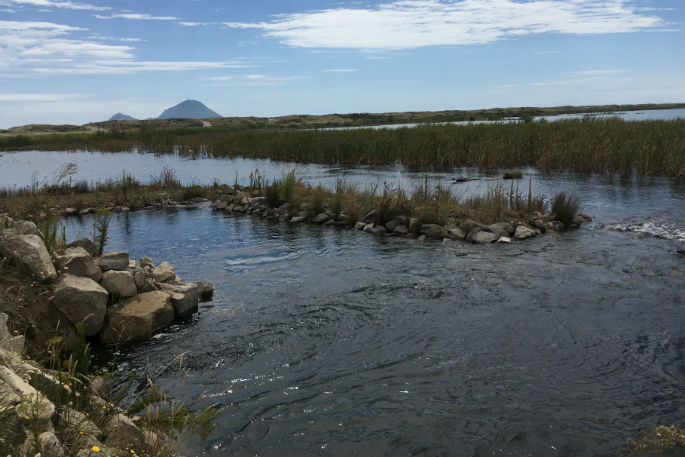Culverts, a fish passage pathway and a natural reed barrier linking the Thorndon/Okorero lagoon with the Rangitaiki River are providing a heathier and more natural future for aquatic life.
The Rangitaiki River Forum requested action be taken in 2014 to reconnect the Rangitaiki River to the Thornton/Okorero Lagoon.
A healthy lagoon is crucial to the wellbeing of coastal and river systems – lagoons provide protected areas to breed and grow and are unique ecosystems for many of native birds, plants and invertebrates.
The area around the lagoon Wildlife Management Area is widely used for recreation with boat launching, bird watching and visitors from the nearby holiday park. The decline of life in the area has been noticed by the Forum over a number of years, says Rangitaiki River Forum Chair Maramena Vercoe.
The Bay of Plenty Regional Council Rivers and Drainage Section worked with local engineers and ecologists to investigate an innovative ‘green design' solution – two culverts running under the causeway.
A 10m long, 1200mm diameter concrete pipe under the causeway provides the bulk of the water exchange, while a higher 600mm diameter pipe nearby provides a water surface for fish navigation at high tide leading into a series of pools, a fish passage pathway and a natural reed barrier.
A key driver for the restoration project is George Johnston, currently the Whakatane District Council member on the Rangitaiki River Forum.
'It was increasingly clear that Okorero [Thornton Lagoon] was getting less and less water from the river so when the water was coming across at high tide, it was stagnant, more brackish and less healthy than it used to be,” says George. 'We were also worried about the weed in the Rangitaiki making its way into the wetland and pushing out the native plants.
'This lagoon is the only remaining wetland on the lower Rangitaiki River that can provide habitat for whitebait species. The lagoon has a resident population of grey mullet that will now be able to enter the river system and give it new life.”
Programme Leader Roger Waugh, says the culverts provide a connection to allow fish to pass easily between the lagoon and the river and allow for additional water exchange between the river and lagoon. A reed cordon helps contain any stray fragments of aquatic weed that might enter the lagoon via the culverts.
'We have already seen an improvement in the overall water quality and we expect that this improvement will lead to an increase in fish life in the lagoon and following that, more birds to feed on those fish. We look forward to seeing the weed inspection zone become a resting place for mullet and kahawai at low tide when swimming to the river is difficult,” says Roger.
A sign will be erected on the site to tell the story of the changes and to point out some of the local bird and aquatic life. It is also a reminder to visitors to take care of the lagoon.
'One of the great things about what we have achieved is that it looks natural, but care has been taken to place those rocks and plants in such a way as to prevent pest weed plants making their way from the river into the lagoon,” says Roger. 'So we ask people who visit to take care of the lagoon and leave the rocks forms as they are to do their job.”
Partial funding for the project has been granted by the Bay of Plenty Regional Council Environmental Enhancement Fund in conjunction with Fish and Game, the Department of Conservation and local volunteer labour and interest.



1 comment
Good on you guys
Posted on 18-06-2017 21:24 | By Papamoaner
There are some high thinkers out there doing good work like this, sadly mostly passing un-noticed. Best of luck with the project.
Leave a Comment
You must be logged in to make a comment.